Abstract
The tasks of an officer of the watch (OOW) on complex ships during navigation in coastal areas may be very challenging. Almost all the tasks require substantial information processing and timely decision making. Every distracting element should be avoided during navigation. Every call, made through any communication system, activates a new process that the OOW needs to conduct. The new process may interrupt a previously started task. In case of too many incoming calls, the workload of the OOW may increase significantly, thus, their situational awareness may be compromised and the risk of errors may increase. The objective of this research was to analyze the impact of incoming voice calls on the OOW. The research methods used include a questionnaire survey and a series of interviews with experienced officers. The main outcomes refer to the average frequency of incoming calls, duration of conversations and subjective assessment of their influence. The results indicate that, during one watch, an officer needs to answer 14 calls that last 16.19 min altogether. However, the officers consider 45% of calls made during watch keeping as distracting. A possible call management system with the aim to reduce distractions made by low priority calls is proposed in this paper.
1. Introduction
The International Maritime Organization (IMO) has adopted a number of regulations and guidelines related to ergonomics and ways of presenting information on a ship’s bridge. However, the continuous development and introduction of new technologies has shown the problem of an overwhelming amount of information presented to the officer of the watch (OOW). Complex control systems where information is displayed in many different forms (digitally and analogously, visually and audibly) and with several independent communication systems may significantly increase the workload of a responsible person, whether it is on a ship’s bridge [1,2,3,4,5] or some other industrial control systems [6]. This situation is emphasized on board by poorly designed systems or by no centralized information management systems [7]. In case of excessive amount of information, which an OOW needs to handle cognitively during a short period, the OOW may become overloaded and lose situational awareness of navigational circumstances. The workload may also increase and the situational awareness decrease if the attention of the OOW is interrupted or if they are distracted during the execution of a certain demanding task [8,9]. The main causes of interruptions, i.e., distractions, are usually personal presence and crew member’ conversations on the bridge, different system alerts and incoming calls through available communication systems.
In general, low level of situational awareness may lead to human error or inappropriate decision-making [10], i.e., to a deviation from a known procedure of actions for which the OOW has been trained [11]. Most accidents at sea have involved human error to at least some degree [12,13,14].
The incoming calls through available communication systems on the ship’s bridge are identified as one of the important distracting elements influencing an OOW [15,16,17]. The incoming calls, as well as notification of different systems’ alerts, demand the immediate attention of the OOW, i.e., in the moment of occurrence, without “choosing” a suitable moment.
It is important to emphasize that besides these mentioned important researches on the matter, and other researches on the workload in maritime industry, the authors could not find any recent scientific papers dealing with the influence of shipboard voice communication systems on the duty officers’ performance.
For the purpose of this research, the communication may be defined as any exchange of information between the OOW on a bridge and one or more other persons. In general, the communication may be divided into verbal and written. The incoming written messages are either received silently (e.g., e-mails) or followed by a respective sound alert if classified as a caution, warning or alarm [18,19]. However, after acknowledging the alert and recognizing its priority and nature, the OOW may choose whether to read the message and act upon it immediately or at a more convenient time. On the other hand, voice calls in the moment of occurrence are either taken or not, which may distract the OOW more than a signal for a written message. Hence, only the incoming voice calls were considered for this research.
Furthermore, for the purpose of this research, the incoming voice communication may be divided into higher priority calls (related to ship’s safety and navigation) and lower priority calls (all other ship’s business), i.e., potentially distracting calls. The communication systems, which are considered to be sources of potential distracting voice calls, are a ship’s satellite telephone, a ship’s mobile telephone, a ship’s internal fixed telephone system and an internal Ultra High Frequency (UHF) radio. Therefore, Very High Frequency (VHF) radio voice communication was not considered for the research.
The main research questions are:
(1) To what extent does the voice communication on a navigational bridge influence the workload of an OOW during navigation? (2) In which manner may distractions activated by incoming voice calls be reduced?
For that purpose, a series of interviews and an extensive survey were conducted. In order to estimate the officer’s workload, the collected data were analyzed by three main indicators. The first one was the frequency of incoming calls in total and divided by communication system type. The second one was the process time, which represented the time spent on a conversation. The process time was estimated per call, system type and in total per each standard watch (4 h). The third indicator was the estimation of how many calls were perceived as low-priority calls, i.e., as distractors, disturbing the officers during watch keeping.
A call management system that could contribute to decrease the number of unnecessary distractions of an OOW and thus improve the safety of a ship during navigation is discussed after the analysis.
2. Research Methods
To collect reliable data on the workload analysis, two sources were used. The first and the main one was the questionnaire survey on active deck officers and the second one was a series of personal interviews with active deck officers. As an additional data source, the official communication log from a Liquefied Natural Gas (LNG) carrier was used.
A total of 104 seafarers participated voluntarily in the survey, out of which 39% were masters, 26% first officers, 25% second officers and 10% third officers. It was emphasized in the survey that the answers should be based on the experience during navigation in a high traffic or coastal area, conducted by one OOW. The questionnaire was structured by using open-ended questions designed to investigate several data sets (Figure 1). The first data set included the frequency of incoming voice calls during coastal navigation through: satellite phone, official mobile phone, ship’s internal phone and internal UHF radio calls. The second data set included process time referring to the time spent in conversation through a certain communication system. The third data set included the subjective estimation on how many incoming calls could be classified as non-important for the ship’s essential safety or security, i.e., as distracting for the OOW in the moment of occurrence. The participants were asked to state the predominant examples of such distracting calls and/or poor communication habits by the crew or the Company.
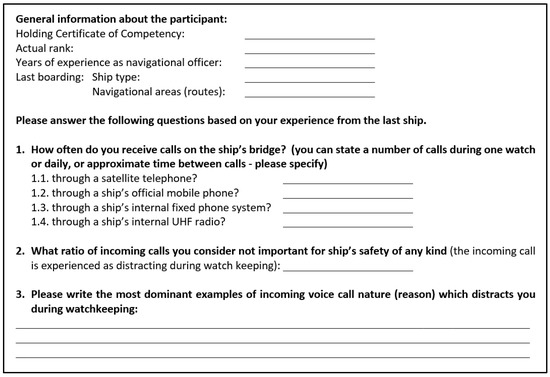
Figure 1.
The survey questions.
Collected data were used for quantitative data analysis, except the data from the 3rd question, which were used for qualitative data analysis.
The second source of data was a series of interviews done with selected participants after the survey. The authors themselves conducted the interviews individually, by using open questions (asking for an explanation) and taking selective notes. The interviews involved 20 officers, navigating actively on ships with modern integrated navigational bridges. Half of them were the first officers and the other half were second officers who represented the most experienced personnel engaged in navigational bridge watches. The objective was to gather their experience on the most frequent nature of calls through every communication system, on the approximate duration of calls, and to clarify the most frequent examples of “distracting” calls.
An additional source to collect the necessary data objectively was the official communication log from an LNG carrier in international trade. The log file contained 62 incoming calls for the period of 3 months during the ship’s extensive exploitation. The communication log file was used to estimate the average process time of incoming satellite and ship’s mobile phone calls.
3. Results
3.1. Satellite Phone Calls
For the purpose of this research, a satellite phone call is an incoming call via one of the satellite voice communication systems installed on a navigational bridge. In most cases, these calls are of a business nature from shore-based parties such as a shipping company employee, a cargo owner’s company employee, a shipping agent, etc. The conversations are usually rather long and made to exchange voyage plan information, cargo plan or state information, different ship’s or crew’s issues, etc. In some cases, the OOW could be asked to summon a senior officer (chief officer, chief engineer or the master) on the bridge to take over the conversation.
The number of these calls was estimated on the basis of the seafarers’ answers in the survey. The seafarers were asked to either state the approximate number of calls during one watch, per day or to state the approximate time between calls. Based on their answers all data were converted to the same expression, which is to the approximate time between calls expressed in minutes. This approach was used for all call types.
In the case of satellite calls the dataset showed a significant heterogeneity, whereas a reliable theoretical distribution could not be determined. The collected data (statistical sample) have the following parameters: Range = 1410 min (30–1440 min), Mean = 763.69, Median = 720, Standard deviation = 570.22 and 90% confidence interval for the mean value [656.2, 871.18]. In such cases, knowing the limit values, a uniform distribution with the equal probability within a limited range [a, b] may be used, and is given by the following expressions:
where a is the minimum limit value and b is the maximum limit value. The limited range based on survey dataset is [0, 1440] expressed in minutes (Figure 2), thus, the distribution is:
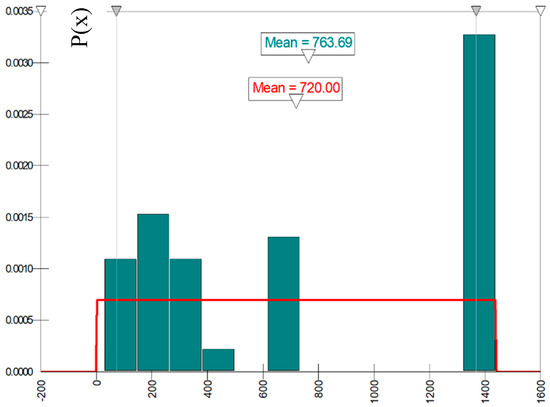
Figure 2.
Time between two incoming satellite calls [min].
The average time between two consecutive calls may be estimated at one call every 720 min or 12 h, i.e., two per day.
To estimate the process time of a satellite call (duration of a conversation) a log file was collected from an LNG carrier in international trade. The collected log file contained 62 incoming calls for the period of 3 months during ship’s exploitation.
The collected data (statistical sample) have the following parameters: Range = 13.58 min (0.01–13.6 min), Mean = 3.73, Median = 2.39, Standard deviation = 3.51 and 90% confidence interval for the mean value [2.92, 4.54]. The data are congruent with the gamma distribution. Gamma distribution is a continuous asymmetrical distribution, which is for the modelling purposes often used for the description of time duration [20] and is given by the following probability density function:
where α is the shape parameter and β is the extent parameter.
Therefore, the process times (tp) of the satellite calls were given in minutes and described by gamma distribution. By rejection of outliners, beyond two standard deviations, the gamma distribution parameters are α = 1.14 and β = 2.80 (Figure 3):
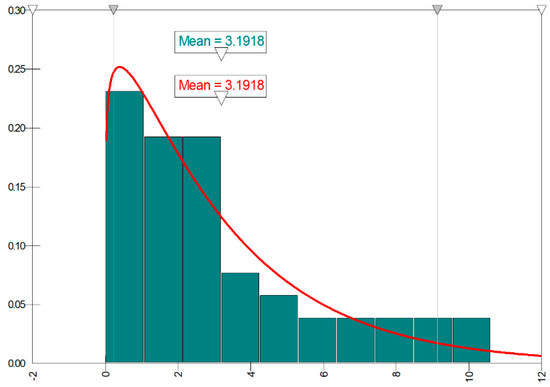
Figure 3.
Satellite call process times [min].
The average process time (duration of the conversation) of an incoming satellite call is 3.19 min. Considering the frequency of incoming calls and their duration, an OOW spends approximately 6.38 min daily talking on the satellite phone. The data from the satellite log that refer to call duration fit in with the answers gathered from the interviews, in which almost all participants answered that most calls had lasted from 1 to 5 min.
3.2. Mobile Phone Calls
A mobile phone call is an incoming call via a ship’s official mobile phone stationed on a bridge during watch keeping. These calls can be made during coastal navigation, i.e., when the ship sails in areas where the mobile signal is available (approximately within 30 km from the shore-based mobile signal antenna).
The number of these calls was estimated on the basis of the seafarers’ answers in the survey. The collected data (statistical sample) have the following parameters: Range=1410 min (30–1440 min), Mean = 376.4, Median = 174, Standard deviation = 456.3 and 90% confidence interval for the mean value [277.96, 474.84]. The data are congruent with the lognormal distribution. By rejection of outliners, beyond three standard deviations the initial distribution parameters are µl = 370.14 and σl = 567.63 (Figure 4), as per the following expressions:
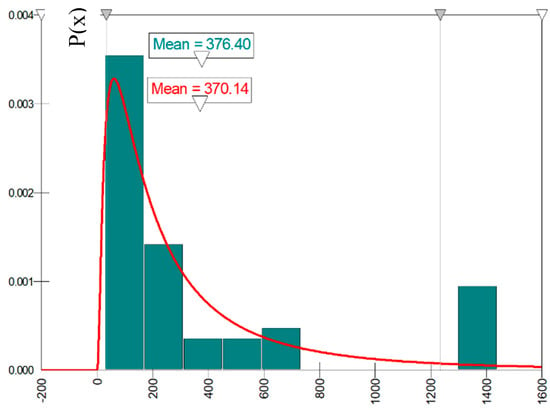
Figure 4.
Time between two incoming mobile phone calls [min].
The average time between two consecutive calls may be estimated at one call every 370.14 min or 6.17 h, i.e., approximately four calls a day. According to the participants’ answers in the interviews, a satellite and a ship’s mobile phone calls are, in most cases, of the same nature, that is, business related. Therefore, the average process time (conversation time) via a ship’s mobile phone is estimated to be the same as in the case of satellite phone calls.
Considering the frequency of incoming calls and their duration, it is estimated that officers of the watch spend approximately 12.76 min talking on the official mobile phone per day. Since satellite and mobile phone calls are not received very often, by analyzing them together as the same source, it can be estimated that an officer receives six calls per day or one per watch.
3.3. Calls through Ship’s Internal Phone
This call type represents the incoming call for the navigational bridge via ship’s internal phone system form a crew member being elsewhere on the ship during navigation. The collected data (statistical sample) have the following parameters: Range = 239 min (1–240 min), Mean = 42.8, Median = 30, Standard deviation = 49.76 and 90% confidence interval for the mean value [31.36, 54.24]. The data are congruent with the lognormal distribution. By rejection of outliners, beyond three standard deviations, the initial distribution parameters are µl = 40.94 and σl = 62.18 (Figure 5). The lognormal distribution is given by the following expressions:
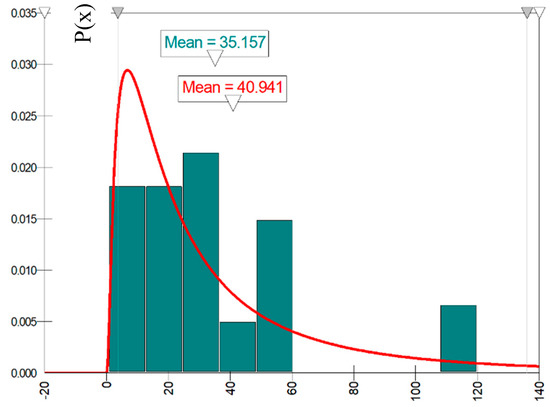
Figure 5.
Time between two incoming calls via ship’s internal phone system [min].
The average time between two consecutive calls may be estimated at one call every 40.9 min or 0.68 h. That frequency generates approximately 35 calls per day or six calls during one standard watch (4 h).
Regarding the process times of these calls, almost all participants of the interview responded that the calls were rather short, usually lasting up to 1 min. The reason for such a short communication time is the nature of calls, which is often limited to asking or providing one or a smaller set of information related to ship’s routine operations.
Considering the frequency of incoming calls and their duration, it is estimated that during one day, officers of the watch spend approximately 35 min (or 6 min during one watch) talking on the official mobile phone.
3.4. UHF Routine Radio Call
A routine UHF call is a non-emergency radio call from a crew member to an OOW on the navigational bridge via ship’s portable handheld UHF radio. The collected data (statistical sample) have the following parameters: Range = 238 min (2–240 min), Mean = 32.28, Median = 15, Standard deviation = 51.88 and 90% confidence interval for the mean value [20.23, 44.33]. The data are congruent to a lognormal distribution. By rejection of outliners, beyond the three standard deviations, the entry parameters are as follows µl = 32.76 and σl = 57.95 (Figure 6). The lognormal distribution is given by the following expressions:
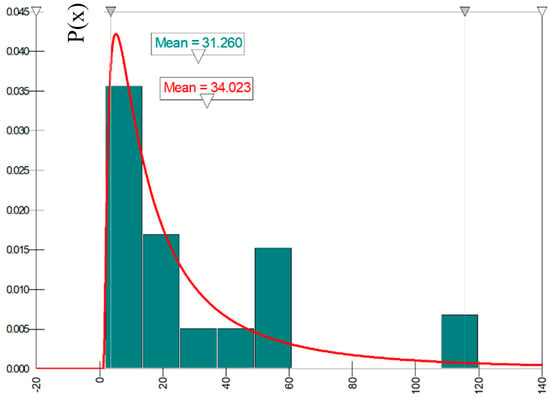
Figure 6.
Time between two handheld UHF radio routine calls [min].
The average time between two consecutive UHF radio calls is 34 min, giving an average frequency of seven calls per watch. It should be emphasized that the majority of the interviewed participants have stated that, on more complex ships, the average time between UHF calls might be 10 min or less, giving the frequency of approximately 24 calls per watch.
The interviewed participants have responded that UHF radio calls were usually rather short, usually lasting up to 1 min, the same as in the case of internal phone calls. The reason is the same, asking or providing one or a smaller set of information related to the ship’s routine operations. However, the major difference is that officers and crew members on duty usually make handheld UHF radio calls with an assigned radio, whereas crew members who do not have an assigned or nearby radio use the ship’s internal phone system.
Considering the frequency of incoming calls via UHF radio and their duration, it is estimated that during one day, officers of the watch spend approximately 42.8 min (or 7 min during one watch) talking on the UHF radio.
Considering all four types of communication systems, it can be estimated that during one watch an OOW has to answer approximately 14 different incoming calls, which last 16.19 min altogether or 6.7% of the watch keeping time.
3.5. Call Importance and Distraction
To determine the importance of incoming calls and how much they influence the performance of an OOW, the seafarers were asked to state how many calls they consider as non-important for the ship’s safety, i.e., how many calls were experienced as distracting. The results have shown that seafarers perceive 45% of all incoming calls as low priority and distracting in the moment of occurrence. The interviewed seafarers have confirmed that during watch keeping and in periods of high-level workload, it would be very useful to somehow avoid (redirect or decline) 45% of incoming calls. The next question of the survey, which asked the participants to state the most common examples of distracting calls, has given quite similar and extensive answers.
The most common nature of distracting calls via satellite and mobile phone include commercial details of the actual voyage, ship’s position, voyage progress and cargo planning details for the next voyage. Shipping companies and/or ship/cargo owners make these calls, although they receive a number of comprehensive written reports on a daily basis. The most common distracting calls made by the ship’s crew through the internal phone system and UHF radio were: an inquiry, namely where are we? or when are we coming?; a confirmation of the ship’s position by the engine officer even though there is a GNSS repeater in the engine control room (usually for the use of incinerators, bilge systems, etc.); a request for the bridge OOW to call a crew member in the watch of other departments; various premature requests for information about the next port, berth, side to which the ship will berth, etc.; inquiries from waiters asking where the chief officer is in order to get a permission to throw food leftovers overboard; reporting on the entry/exit of each person in/from an enclosed space (which should be organized differently); and a number of other examples of private communication between crew members and crew members on watch on the bridge.
The OOW on the bridge may be in different demanding situations during navigation, which for some officers may increase the workload level significantly. Rather common demanding situations include navigation in dense traffic areas, coastal navigation, avoiding collision maneuvering, waypoint turn, communication with external subjects (e.g., vessel traffic service or other ships in vicinity), planning the alteration of the actual voyage, etc. While executing a certain procedure (a series of actions of one or more tasks), if distracted, the officer must pause the procedure until the distraction is over. Therefore, when the officer returns to the paused procedure, they need some time to perceive where they were interrupted and what should be the next action. In some cases, a certain interrupted action or a task has to be started from the beginning. The OOW has to answer the incoming calls on the bridge. They should answer the internal phone system calls or a UHF radio calls as soon as possible, because the call could be related to the ship’s safety or security. This responsibility is often laid down in the Master’s standing orders or some other documents in the ship’s safety management system describing the OOW responsibilities. On the other hand, the incoming calls through the satellite or ship’s mobile phone refer mostly to the commercial activities and not to the ship’s safety, thus, the OOW can choose whether it is appropriate to answer the call or not, depending on the prevailing situation on the bridge. However, in most of the cases, the officers answer such calls no matter the situation on the bridge. The interviewed seafarers have stated that such behavior is noted among younger officers, because they perceive these calls as very important ones and they want to avoid discussions as why they were not able to take a call from the influential company persons.
On the other hand, a person calling the ship’s bridge, whether they are on the same ship or not, is hardly aware of the actual situation on the bridge, i.e., whether the OOW is in a demanding situation, executing complex actions and experiencing high level workload. In other words, the person making the call does not know if it is appropriate to disturb the OOW in a certain moment, and whether that call will, as a consequence, reduce the level of ship’s safety for a certain period of time.
During the watch on the bridge, especially during demanding situations, the number of distractors (activated by equipment or people) should be minimized. In the case of incoming calls, a call management system that could differ important calls, i.e., all calls related to ship’s safety and security, from all other less important calls, could increase the ship’s safety by minimizing the distractions of the OOW.
4. Call Management
A call management system could be implemented on all communication systems, which were a part of this research. However, with substantially different approaches. The call management of the UHF radio system is quite simple and differs from all other systems. In this case, the simple organization and regulation through the ship’s Safety Management System could decrease the distractions of the OOW, simply by allocating different UHF channels for routine communication and for important safety related calls. In that case, the OOW should have the UHF radio on the bridge set up on the channel allocated to important calls. However, this system cannot prevent its own misuse. Some crew members could still call the bridge asking for non-important details. Furthermore, it cannot be used to select and reject calls automatically, or to divert a certain type of call. Consequently, the OOW decides whether they will answer the call and how fast.
It is technically possible for the other three systems (satellite, mobile and internal phone system) to manage different calls before the phone starts ringing on the ship’s bridge. A technical solution to the problem that is not highly complex is a call management system offering priority call selection (Figure 7). For this system to work efficiently, it is important for the caller to know how to recognize the importance of the call and thus how to select the appropriate call procedure. In that case, the caller has an option to choose whether the call is a routine one (low priority) or a high priority one (by a special number sequence or a built-in button) and, consequently, to establish the immediate connection with the bridge.
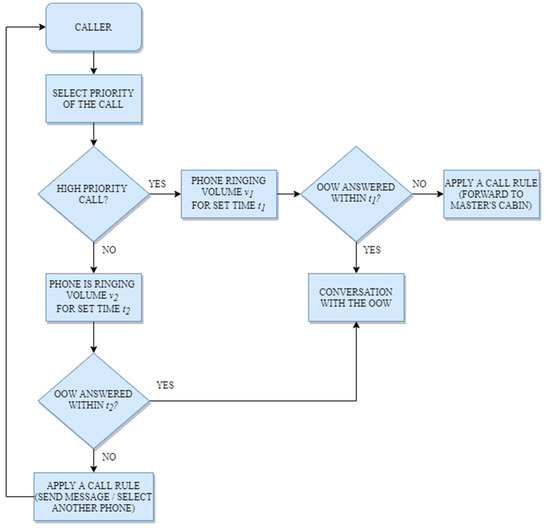
Figure 7.
Call management system.
Once a certain call reaches the bridge, it should be easily recognized by the OOW. High priority calls on the bridge should sound an alert (ringing tone) using a certain, easily recognizable sound pattern of higher volume that a low priority call does not have. In case the OOW does not answer within a given (rather long) ring time, the system should apply a certain rule to manage the call e.g., redirect the call to the master’s cabin (Figure 7). On the other hand, low priority calls should not ring constantly. They should use sound patterns with more silent periods and with lower volume. Another significant difference is that a low priority call should not ring as long as a high priority call. Instead, it should ring for a rather short period (e.g., 10 s), after which a certain rule (management method) should be used. The idea of such a short ringing time is to inform the OOW and provide them the opportunity to answer it, if the time is appropriate. If the OOW does not answer after the initial ringing time, the system should manage the call further by applying a certain rule.
Low priority call managing methods, i.e., rules, which may be applied in case the OOW did not answer within a given time, include forwarding or rejecting the calls. Call forwarding may be used to redirect the call to another defined phone unit (backup) or even to give the choice to the caller to select and reach a certain person or a department (e.g., master, chief engineer, engine control room, etc.). Call rejection may be organized in a way that a recorded message informs the caller that the OOW is not able to answer the call and to try again later.
One of the solutions to the problem of voice calls’ priorities is the application of the Multilevel Precedence and Preemption (MLPP) service in the call management system. The MLPP is a priority scheme for (a) assigning one of several precedence levels to specific calls or messages so that the system handles them in a predetermined order and time frame, (b) for gaining controlled access to network resources in which calls and messages can be preempted only by higher priority calls and messages, (c) that is recognized only within a predefined domain and (d) in which the precedence level of a call outside the predefined domain is usually not recognized [21]. The term precedence indicates the priority of the outgoing call, while the term preemption indicates the current call termination when a higher priority call is received. In the standard MLPP service, such as in the one used in Cisco Unified Communications Manager [22] there are five levels of priorities: Highest Level—Flash Override (level 0), Second-Highest Level—Flash (level 1), Third-Highest Level—Immediate (level 2), Fourth-Highest Level—Priority (level 3) and Routine (level 4). For such a system to work, the system administrator needs to define an access digit for priority calls and assign a maximum precedence level (0–4) to individual phone(s), i.e., for satellite, mobile and/or internal phone systems. Therefore, when making a priority call in a certain communication system, the caller needs to dial the access digit and the required precedence level (0–4) before dialing the needed phone number.
All of the above-mentioned features can be easily implemented as an on-board call management system [22]. For example, the indication status of the MLPP service can be set to determine ringing tones and indications for a priority call. This indication can be a special tone (alert) or a display notification for both the calling and called side. In addition, the alternate party timeout parameter could be set to determine the time before the priority call is forwarded to the alternative route. These settings provide the configuration of an alternative destination for priority calls that could not be answered. Moreover, there is a setting that determines the duration of ringing (in seconds) before forwarding a priority call.
The main advantage of such a call management system would be that the OOW would know, by the sound of phone ringing itself, if the call is of high or low priority. In the case of a low-priority call, the OOW may choose whether to answer it or not, depending on the prevailing situation on the bridge and his/her workload level. On the other hand, the main drawback would be the familiarization of the usual callers (crew and employees ashore) with new calling procedure and, consequently, learning it. The calling procedure should be stated officially in the Safety Management System. Another drawback is the fact that the OOW on the bridge should learn more ringing patterns (sounds) in order to recognize different call priorities.
5. Research Limitations
This research has a limitation that has to be emphasized. The collected data referring to the frequency of incoming calls and their duration were based solely on the questionnaire survey. The participants of the survey have answered the questions based on their subjective opinion and the ability to recall the call particulars. Such an approach cannot provide data of high reliability and accuracy on the matter, hence, the results obtained by this research should be considered as estimated and used carefully. Further research of this kind should be based on more objective data sources, primarily on detailed and extensive phone logs for all types of communication systems studied. Another challenge experienced during this research that refers to confidentiality issues was the willingness of shipping companies to provide such call logs for the research purposes.
6. Discussion and Conclusions
The incoming voice call requires from the OOW to answer the call immediately. Only after answering the call, the OOW may determine its importance. Depending on the nature and the course of the conversation, OOW decides on the future course of action during or after the call (e.g., gathering, processing, forwarding or sharing information, actions on a specific ship’s system, log keeping and other). Furthermore, if the OOW was already conducting a certain procedure, by answering the call the procedure would be interrupted. After the interruption the procedure may be continued or started all over, depending mostly on its complexity and the officer’s competences. The first research question was “To what extent does the voice communication on a navigational bridge influence the workload of an OOW?” The research has shown that, considering all four types of communication systems, it can be roughly estimated that during one watch an OOW has to answer 14 different incoming calls, which last, altogether, 16.19 min, or in other words, 6.7% of watch keeping time. Taking into consideration the main findings and nature of calls it is not surprising that seafarers experience 45% of all incoming calls as distracting, i.e., unnecessarily interrupting a previously started procedure. This issue is particularly important in demanding situations in navigation, such as collision avoidance, navigation in dense traffic or in restricted areas, course change on a waypoint, distress or urgency message receipt or similar.
Some demanding situations during navigation, such as collision avoidance or course change on a waypoint, can last for several minutes. During these actions, one low-priority call distracting an officer from 1 to 3 min can significantly reduce their situational awareness. Furthermore, new satellite communication systems have constantly been developing and the existing ones have been improving, making the global communication more reliable and affordable. Similarly, terrestrial mobile system networks have constantly been expanding by building new and more powerful signal antennae. On the other hand, by introducing new, complex ship systems with a high level of automation, a global tendency to reduce the ship’s crew size arises. Considering all the above, it is justified to assume that the external calls from the shore will be more frequent and will probably last longer in the future.
The second research question was “In which manner may distractions, activated by incoming voice calls, be reduced?”
One of the possible approaches to the problem is to develop and implement the proposed advanced call management system. Such a call management system would allow the caller to decide whether the nature of the call is of higher or lower priority. Consequently, depending on the priority, call notification on the bridge would be different (in type, volume and duration) as well as further actions in case the OOW cannot answer.
The main advantage of such a system is that an OOW would know the call priority before answering it and interrupting the previously started procedure. Hence, the OOW could manage their workload by deciding which further actions to take, depending on the complexity of the ongoing navigation situation.
The main drawbacks refer to the requirement for a certain level of training and familiarization with a particular call management system and to the introduction of new, different sounds (alerts) on the bridge, which the OOW would have to recognize.
Based on all these findings, further research on workload, induced by different aspects of communication, will be necessary, particularly for finding the appropriate solution to prevent unnecessary distractions.
Author Contributions
Conceptualization, L.M. (Lovro Maglić) and S.V.; methodology, L.M. (Lovro Maglić), S.V., A.G. and L.M. (Livia Maglić); software, L.M. (Lovro Maglić) and S.V.; validation, L.M. (Lovro Maglić) and S.V.; formal analysis, L.M. (Lovro Maglić), S.V., A.G. and L.M. (Livia Maglić); investigation, L.M. (Lovro Maglić), S.V. and A.G.; resources, L.M. (Lovro Maglić); data curation, L.M. (Livia Maglić); writing—original draft preparation, L.M. (Lovro Maglić), and S.V.; writing—review and editing, L.M. (Lovro Maglić), and S.V.; visualization, A.G.; supervision, L.M. (Lovro Maglić); project administration, L.M. (Livia Maglić); funding acquisition, L.M. (Lovro Maglić), S.V., A.G. and L.M. (Livia Maglić). All authors have read and agreed to the published version of the manuscript.
Funding
This work has been financially supported by University of Rijeka under the Faculty of Maritime Studies projects.
Conflicts of Interest
The authors declare no conflict of interest.
References
- Tzannatos, E.S. GMDSS False Alerts: A Persistent Problem for the Safety of Navigation at Sea. J. Navig. 2004, 57, 153–159. [Google Scholar] [CrossRef]
- Embrey, D.; Blackett, C.; Marsden, P.; Peachey, M. Development of a Human Cognitive Workload Assessment Tool: MCA Final Report; Human Reliability Associates: Dalton Lancashire, UK, 2006. [Google Scholar]
- Nachreiner, F.; Nickel, P.; Meyer, I. Human factors in process control systems: The design of human–machine interfaces. Saf. Sci. 2006, 44, 5–26. [Google Scholar] [CrossRef]
- Earthy, J. Raising the alarm. Horizons 2006, 15, 10–11. [Google Scholar]
- Mišković, D.; Bielić, T.; Čulin, J. Impact of Technology on Safety as Viewed by Ship Operators. Trans. Marit. Sci. 2018, 7, 51–58. [Google Scholar] [CrossRef]
- Goel, P.; Datta, A.; Mannan, M.S. Industrial alarm systems: Challenges and opportunities. J. Loss. Prevent. Proc. Ind. 2017, 50, 23–36. [Google Scholar] [CrossRef]
- International Maritime Organization. Development of an E-Navigation Strategy Implementation Plan. NAV 59/6; International Maritime Organization: London, UK, 2013. [Google Scholar]
- Krystosik-Gromadzińska, A. Ergonomic assessment of selected workstations on a merchant ship. Int. J. Ind. Ergonom. 2018, 24, 91–99. [Google Scholar] [CrossRef]
- Maglić, L.; Zec, D.; Frančić, V. Model of the Adaptive Information System on a Navigational Bridge. J. Navig. 2016, 69, 1247–1260. [Google Scholar] [CrossRef]
- Crowch, T. Navigating the Human Element; MLB Publishing: Kent, UK, 2013. [Google Scholar]
- Øvergård, K.I. Human Error: Causality and the Confusion of Normative and Descriptive Accounts of Human Performance. In Creating Sustainable Work Environments, Proceedings of the Nordic Ergonomic Society 47th Annual Conference, Lillehammer, Norway, 1–4 November 2015; Fostervold, K.I., Johnsen, S.Å.K., Rydstedt, L., Watten, R.G., Eds.; Norwegian Society for Ergonomics and Human Factors: Lysaker, Norway, 2015; pp. C5-6–C5-10. [Google Scholar]
- Rowley, I.; Williams., R.; Barnett, M.; Peckan, C.; Garfield, D.; Northcott, L.; Crick, J. Development of Guidance for the Mitigation of Human Error in Automated Ship-Borne Maritime Systems; Project Report RP545 MSA10/9/210 for the Maritime and Coastguard Agency; Qinetiq: Southampton, UK, 2006. [Google Scholar]
- Rothblum, A.M.; Wheal, D.; Withington, S.; Shappell, S.; Wiegman, D.A.; Boehm, W.; Chaderjian, M. Human Factors in Incident Investigation and Analysis. In .Proceedings of the 2nd International Workshop on Human Factors in Offshore Operations (HFW2002), Groton, CT, USA; U.S. Coast Guard Research & Development Center: New London, CT, USA, 2002. [Google Scholar]
- Dhillon, B.S. Human Reliability and Error in Transportation Systems; Springer: London, UK, 2007. [Google Scholar]
- Sandhåland, H.; Oltedal, H.; Eid, J. Situation awareness in bridge operations—A study of collisions between attendant vessels and offshore facilities in the North Sea. Saf. Sci. 2015, 79, 277–285. [Google Scholar]
- Sandhåland, H.; Oltedal, H.; Hystad, S.; Eid, J. Distributed situation awareness in complex collaborative systems: A field study of bridge operations on platform supply vessels. J. Occup. Organ. Psychol. 2015, 88, 273–294. [Google Scholar] [CrossRef] [PubMed]
- Loukopoulos, L.D.; Dismukes, R.K.; Barshi, I. The Multitasking Myth: Handling Complexity in Real-World operations; Ashgate Publishing, Ltd.: Farnham, UK, 2009. [Google Scholar]
- International Maritime Organization. Code on Alerts and Indicators; Resolution A.1021(26); International Maritime Organization: London, UK, 2009. [Google Scholar]
- International Maritime Organization. Adoption of Performance Standards for Bridge Alert Management (BAM); Resolution MSC.302(87); International Maritime Organization: London, UK, 2010. [Google Scholar]
- Rossetti, M. Simulation modeling and Arena. 2nd. ed.; John Wiley & Sons, Inc.: Hoboken, NJ, USA, 2016. [Google Scholar]
- Weik, M.H. Multilevel Precedence and Preemption. In Computer Science and Communications Dictionary; Springer: Boston, MA, USA, 2000. [Google Scholar]
- Bateman, D. Configuring Cisco Unified Communications Manager and Unity Connection: A Step-by-Step Guide; Cisco Press: Indianapolis, IN, USA, 2011. [Google Scholar]
© 2020 by the authors. Licensee MDPI, Basel, Switzerland. This article is an open access article distributed under the terms and conditions of the Creative Commons Attribution (CC BY) license (http://creativecommons.org/licenses/by/4.0/).